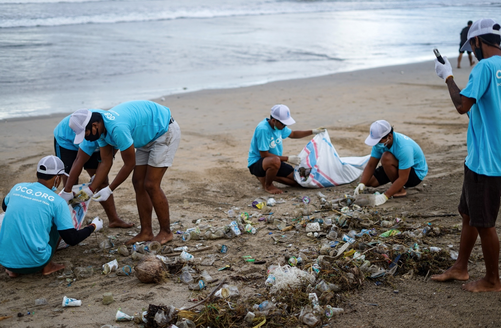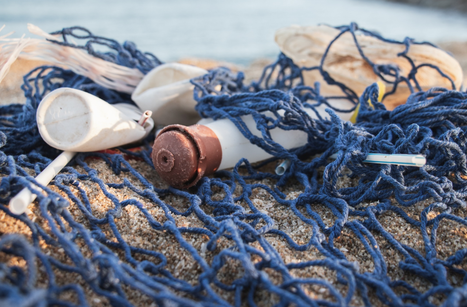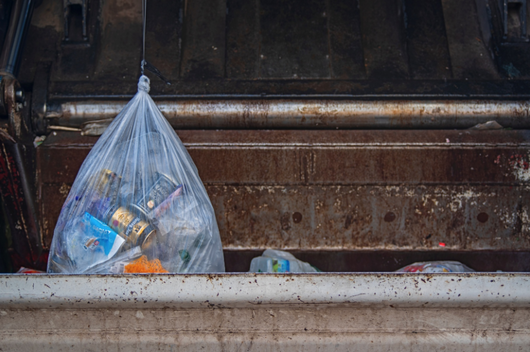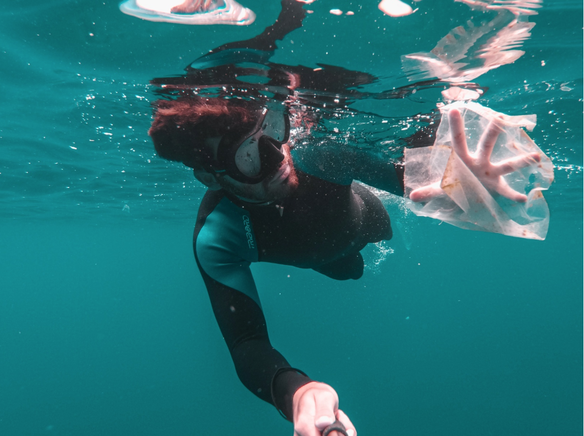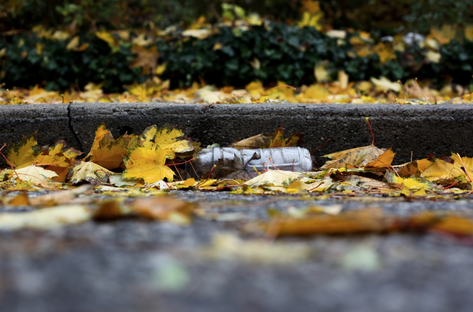 Photo by Jasmin Sessler on Unsplash Photo by Jasmin Sessler on Unsplash Plastic, previously lauded for its longevity, has become a serious threat to the planet. From our kitchens to roadsides, hanging with the branches of the trees to floating in our water channels, from deep oceanic trenches to far north at the highest of the peaks--it is found everywhere! Our life is incomplete without single-use plastics like plastic bags, bottles, coffee cups, straws, grocery and trash bags, food packaging and storage containers, utensils and cutlery, just to name a few. All of these single-use plastics are responsible for a major chunk (about 40%) of plastic pollution, particularly in the marine environment. Being a fossil product, it takes up to 1,000 years to naturally degrade, meaning that every bit of plastic ever produced still exists, either in landfills or oceans. But this hasn’t affected its production, which has been soaring since the 1950s and became popular in the 1970s, then replaced paper by the end of the 1980s. According to a 2017 study, about 18.2 trillion pounds of plastic has been produced so far, and the number is bound to double by 2050. Plastic bags are among the top five items that are found in beach cleanups. According to the Earth Policy Institute, two million plastic bags are used per minute. The average life of a single bag is only 15 minutes, however! Unfortunately, most of the plastic isn’t recycled. It is simply carried away by wind or water runoff down the streams and directly into our oceans. Most of these plastics, such as discarded fishing nets and six-pack rings, lead to the entanglement and death of marine organisms, particularly seals, sea turtles, whales and dolphins. According to WWF, fishing gear has been responsible for 300,000 deaths per year. But, the problem doesn’t end there. At the dumpsites or landfill sites and in the oceans, plastic degrades under sunlight into smaller chunks, less than 5 mm, which are known as microplastics. And guess what! Our marine organisms are already saturated with these microplastics because they mistake them for food. Even a newly discovered marine crustacean was named after its plastic-biomass as Eurythenes plastic. With the warming of the oceans, scientists are concerned about the effects of toxic chemicals released into the water. We need to fight off this nuisance, and many countries around the world have already enacted a ban on single-use plastic. Bangladesh was the first country to put a ban on plastic bags in 2002. California was the first state in the U.S. to put a ban on single-use plastic bags in 2014 and plastic straws in 2018. The ban also required a 10-cent fee for recycled paper bags, reusable plastic bags, and compostable bags. Connecticut, Columbia, Delaware, Idaho, Illinois, Maine, Mississippi, Oregon, Tennessee, Vermont, and New York joined the cause in 2019. Other countries following the trend include Australia, Bangladesh, China, Canada, Denmark, European Union, France, India, Ireland, Iceland, Kenya, Mexico, Morocco, Rwanda, Thailand, United Kingdom, to name a few. According to the United Nations 2019 statistics, 127 countries have imposed a ban on plastic bags. Many others have pledged to reduce their plastic pollution by drafting policies for regulating plastic. All forms of plastic are toxic to human health and marine wildlife. Microbeads that were extensively used in cosmetics products have been banned in U.S., Canada, and New Zealand. A heavy fine is levied on the retailers for the sale of banned plastic bags in Australia. European Union banned ten disposable plastics, including single-use straws and styrofoam, and requires manufacturers to produce plastic bottles from 30% recycled content by 2030. Rwanda has strictly prohibited the manufacture, sale and import of single-use plastic carrier bags. Even the poorest of the countries in the Sub-Saharan region have enacted plastic ban and taxes. Many companies are also taking the initiative to reduce their plastic footprint. One such example is Starbucks Coffee Korea that announced to phase out the use of single-use cups from its 1,500 Korea-based coffee shops by 2025. Maybe you're thinking why this is happening in Korea and nowhere else? After China announced a ban on recyclable plastic scrap import to reduce its environmental impact (I will come to this point next), the Korean government had no choice but to push Starbucks to make this commitment. Previously, the company was bound, as per agreement between the Ministry of Environment and coffee franchises, to offer a discount worth $0.30 to anyone who brings their reusable cups. 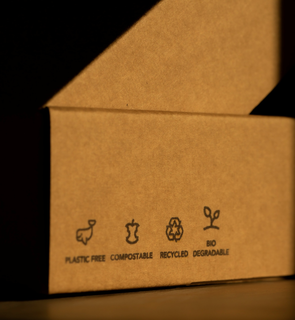 Photo by Marcell Viragh on Unsplash Photo by Marcell Viragh on Unsplash Why aren’t we seeing less plastic despite all these bans? About 9 million metric tonnes of plastic ends up in the oceans every year, where it negatively affects the health of the marine ecosystem. Small chunks of plastics have already entered the food chain, thus affecting human health as well. And the production of this sea monster is forecasted to be doubled by 2050. Here are a few reasons why these bans aren’t as effective as proposed to be;
Scientists urge that replacing plastic with paper bags isn’t an eco-friendly solution. The carbon footprint of paper is much more than plastic, and it would also impact the environment in terms of climate change. Furthermore, even if we shift to a zero-plastic lifestyle, what are we going to do about the plastic that’s already lingering in the environment? We need to replace plastic with sustainable alternatives such as compostable or biodegradable packaging and reusable plastic bags. Other people argue that a ban on single-use plastic is ineffective unless the fishing industry is taken under plastic regulations. Discarded fishing gears comprised 46% of the ocean debris. Thus, inspired by the documentary, "Seaspiracy", the group demands radical measures like banning commercial fishing to marine tackle plastic pollution. While most campaigns highlight the importance of plastic recycling, the world is now grappling with another big issue. China, which was the biggest importer (51%) of recyclable waste, has banned shiploads of 24 types of scraps under its National Sword policy in 2017 as an effort to reduce its plastic footprint. This has dropped its import to 99% from the pre-ban levels. And, many other developed countries have halted their recycling programs because of their luxurious costs. America, which used to export a whopping 74% of its recyclable plastic to China, is now shipping it to Canada and Malaysia. This has significantly reduced the exports by 60% since 2017. The U.S. is currently holding on to more of its discarded plastic than the recycling infrastructure allows. New legislation known as the 'Break Free from Plastic Pollution' Act 2021, introduced by Senator Jeff Merkley and Alan Lowenthal, has raised our hopes. The act puts the burden of plastic waste management on the producers and corporations rather than the taxpayers, municipalities, and communities. It is also proposed to incentivize businesses for manufacturing recyclable products, ban non-recyclable single-use plastic, and improve local recycling and composting infrastructure. While many countries are practicing plastic ban, others have shifted to sustainable plastic alternatives. Some of these include;
A plastic ban is a promising approach, and our governments are working tirelessly to fight off this nuisance. But, there’s so much we can do at individual levels. Like we always say, we can start with the simple 3Rs (Reduce, Reuse, Recycle) and avoid the 3Bs (Burry, Burn, or Borne out of the sea, I read somewhere). Let us know in comments how you plan on reducing your plastic footprint! We’d love to share it with the world! (optional) AuthorNida Riaz is a freelance blogger based in Pakistan. She started writing about her passion for the environment when the world came to a stop in early 2020.
0 Comments
Leave a Reply. |
|
|
(833) CMS-LINE
(833) 267-5463 PO Box 13477 Mill Creek, Wa, 98082 © Conservation Made Simple. All rights reserved.
501(c)(3) Non-Profit, Tax ID#: 82-1646340 Copyright © 2021 Conservation Made Simple |

